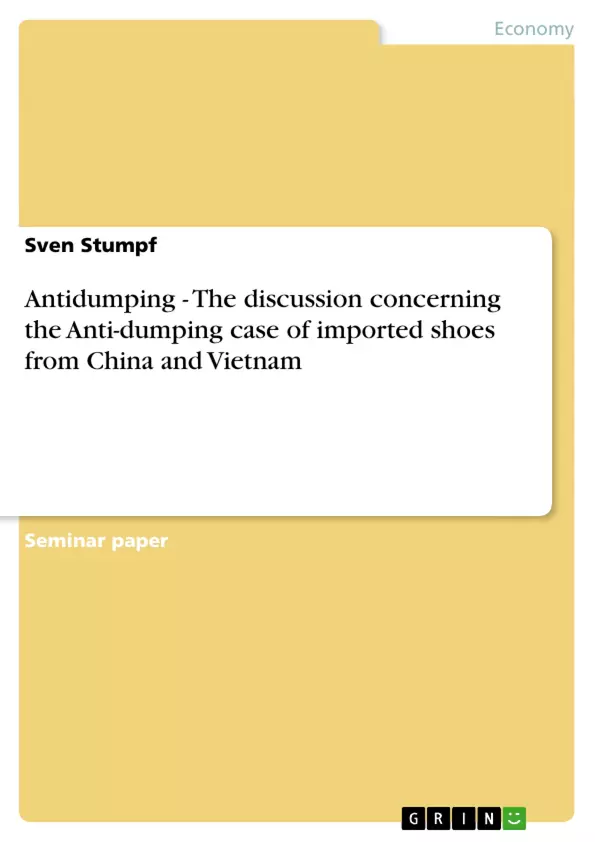The press release of the European Commission of October the 5th was short, but the impacts and the story behind the release was more than eminent for Europe, China and Vietnam. On October the 5th the Council adopted a definitive anti dumping duty on imports into the EU of special leather footwear from China and Vietnam starting October the 7th. This measure will be installed for two years. The regulation is aimed at protecting the EU footwear market by imposing duties of 16,5% and 10% on leather footwear imports from China and Vietnam, respectively1. Before the installing of the measures the Commission initiated investigations in July 2005. In April provisional anti dumping duties had been adopted.
The following paper will tackle the topic of the anti-dumping measures adopted by the European Commission. First, I will go over the definition of dumping. After this, I will explain the role of the WTO in cases of dumping. In the next chapter I will talk about dumping cases in the EU from China in general. The next part deals with the case of anti dumping, concerning special leather shoes from China and Vietnam. Different voices from Europe and China will be covered, including the discussion of the impacts of the adopted measures.
Inhaltsverzeichnis (Table of Contents)
- Introduction
- Definition
- WTO and Dumping
- EU and Dumping
- EU and Dumping in general
- EU and the Chinese shoe dumping case
- Voices from Europe
- Voices from China
- Discussion of impacts
- Price increase
- Unemployment
- Reduced choice
- Further arguments
- Reference
Zielsetzung und Themenschwerpunkte (Objectives and Key Themes)
This paper analyzes the European Commission's anti-dumping measures against imported leather footwear from China and Vietnam. The main objective is to examine the definition of dumping, the role of the WTO in such cases, and the specific context of the Chinese shoe dumping case in the EU. This paper also investigates the impact of the anti-dumping measures on the EU footwear market, including potential price increases, unemployment, and reduced consumer choice.
- Definition and implications of dumping in international trade law
- Role of the World Trade Organization (WTO) in regulating dumping practices
- Analysis of the specific case of Chinese shoe dumping in the EU
- Impact of anti-dumping measures on the EU footwear market
- Voices and perspectives from both Europe and China regarding the anti-dumping measures
Zusammenfassung der Kapitel (Chapter Summaries)
- Introduction: This chapter introduces the context of the anti-dumping measures adopted by the European Commission against leather footwear imports from China and Vietnam. It highlights the significance of the decision for both the EU and the exporting countries.
- Definition: This chapter defines dumping in the context of international trade law. It explains how dumping is seen as a form of predatory pricing and its potential advantages for exporting companies. The chapter also addresses the potential impact of dumping on consumers, workers, and domestic industries.
- WTO and Dumping: This chapter explores the role of the World Trade Organization (WTO) in regulating dumping practices. It outlines the WTO's trade defense instruments, including safeguards, anti-subsidy, and anti-dumping measures. The chapter also explains the WTO's definition of dumping and its methods for determining fair value.
Schlüsselwörter (Keywords)
This paper focuses on key concepts such as anti-dumping, trade law, WTO agreements, price discrimination, predatory pricing, market share, monopoly, subsidies, fair value, and the impact of these measures on the EU footwear market. It examines the specific case of Chinese shoe dumping in the EU and explores the voices of both European and Chinese stakeholders.
- Quote paper
- Sven Stumpf (Author), 2006, Antidumping - The discussion concerning the Anti-dumping case of imported shoes from China and Vietnam , Munich, GRIN Verlag, https://www.hausarbeiten.de/document/70320


